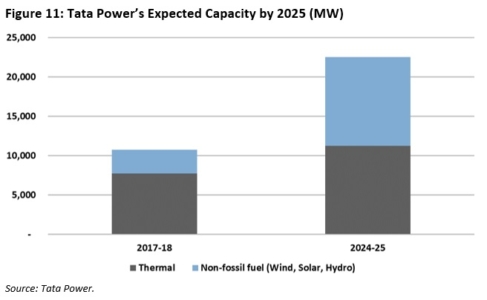IEEFA report: Tata Power exemplifying the Indian energy transition
April 23, 2019 (IEEFA India) – India’s largest private integrated power company – Tata Power – has recently made it publicly clear that it will cease building new coal-fired capacity, according to a report released today by the Institute for Energy Economics and Financial Analysis (IEEFA).

The report, Tata Power: Renewables to Power Growth, highlights the company’s long-term strategy that will see renewable energy dominate its power capacity build-out going forward.
Tata Power is now leading the country’s renewable energy transition following its withdrawal from building new coal-fired power plants.
Report co-author Simon Nicholas, Energy Finance Analyst at IEEFA, says Tata Power’s focus on renewables makes sense given the major energy transformation now occurring.
“The company’s plan, Strategic Intent 2025, calls for up to 70% of new capacity additions to come from solar, wind and hydro through to 2025,” says Nicholas. “This represents a significant departure from the accepted wisdom of just a few years ago that a major expansion of coal-fired power would be required to serve India’s growing electricity demand.”
The majority of Tata Power’s thermal capacity is now centred on its Mundra coal-fired power plant – one of the biggest power plants in India – which experienced losses reaching US$ 191M for the first three quarters of FY 2018-19.
“The Mundra plant is recording consistent, significant losses that are dragging down the company’s overall financial performance,” says Nicholas. “While a bailout of the plant is being planned which will increase the tariff burden on consumers and realise a debt write-down for bank lenders, Tata Power has stated it will only halve the losses at Mundra.”
Tata Power’s experience at Mundra has helped convince the company to turn away from new coal-fired power.
Tim Buckley, IEEFA’s Director of Energy Finance Studies and co-author of the report, notes that Tata Power’s shift mirrors the transition underway within the Indian power sector as a whole, driven by least cost renewable energy.
“The shift away from new coal-fired power is moving faster than anyone had predicted,” says Buckley. “The current Indian fiscal year has seen net coal-fired power additions come close to ceasing altogether.”
Peak coal-fired power capacity in India is on the horizon, according to the IEEFA analysts, and growing electricity demand will be served by current coal power capacity and rapidly growing renewable energy capacity.
“Tata Power encapsulates this rapid transition,” Buckley says.
Tata Power will need to increase renewables significantly if it is to meet its Strategic Intent targets by 2025.
With more than 40 gigawatts of existing coal-fired power plants under financial stress in India, Tata Power is seeking to only add new coal-fired power capacity via fire-sale acquisition, at 30%-40% of historical investment. It no longer plans to build new coal-fired power plants.
Tata Power’s renewables operations are profitable, recording earnings before interest, depreciation and amortisation (EBITDA) of US$ 249M in FY 2017-18, and an EBITDA margin of 89%.
The company is also leading India in rooftop solar, electric vehicle charging, and via its recent installation of India’s first grid-scale battery storage system alongside Mitsubishi Corporation and AES India.
However, Tata Power will need to increase its renewables installation rate significantly if it is to meet its Strategic Intent target of reaching up to 11.3 GW of non-fossil fuel power capacity by 2025.
“Leading utilities like Tata Power are assisting to make the energy transition in India’s power system a reality,” says Nicholas. “Although the company is not alone in doing so, it is one of the best examples of that transformation in action.”
Read the report: Tata Power – Renewables to Power Growth
Media contact: Kate Finlayson ([email protected]) +61 418 254 237
Analysis: Simon Nicholas ([email protected]) +61 40 583 1614
Tim Buckley ([email protected]) +61 40 810 2127
About IEEFA: The Institute for Energy Economics and Financial Analysis (IEEFA) conducts research and analyses on financial and economic issues related to energy and the environment. The Institute’s mission is to accelerate the transition to a diverse, sustainable and profitable energy economy.












